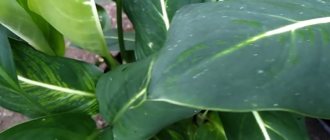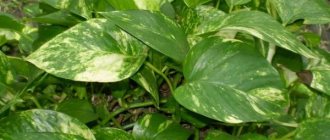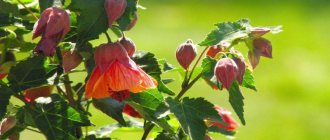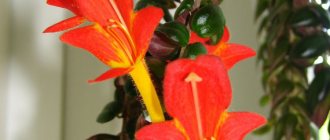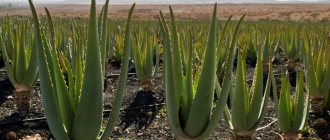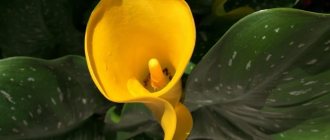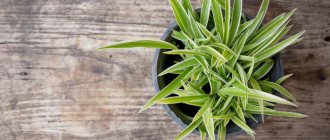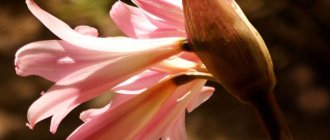Cyclamen is a houseplant belonging to the class of dicotyledons, subfamily Myrsinaceae of the Primrose family. The perennial herbaceous flower is also called alpine violet, and popularly called woody violet. Today there are about 50 varieties. In Russia it grows in the Krasnodar region.
Dear readers! For you, we have created communities on social networks in which useful articles and interesting ideas are published several times a day! Subscribe and receive useful content in a convenient format!
Caring for alpine violet (cyclamen) after purchase
Alpine violets react sharply to changes in habitat. During this period, the flower is a little wilted, the flowers are drooping, but this is a normal phenomenon if the care requirements are followed in the future.
First, inspect the flower. If there are damaged leaves or flower stalks, carefully remove them with garden shears. Within a few days or immediately, cyclamen must be replanted.
Note! If you purchased the plant in a flowering state, postpone replanting until the end of the dormant period.
For the first 3 weeks, place the plant in a secluded place on the bright side so that it does not contract the disease.
Caring for cyclamen at home - what needs to be done after purchasing it in a store
The first rule of caring for European or Persian cyclamen at home: inspect the plant and identify the need for replanting. This will be necessary if your new pet is growing in transport soil and is in a dormant period.
- If you notice after a couple of days that the plant has noticeably become “sad,” dropping leaves and flower stalks, then this is a manifestation of acclimatization to your room conditions.
- If you select the optimal location and living conditions, the flower will quickly perk up.
- If the earthen ball is dry, then watering is carried out through a pan.
- Feeding is not needed until 2-3 months if your cyclamen has good soil.
Catalog of indoor flowers with photos and their names. In a special publication on our portal we will talk in detail about indoor flowers. You will learn the types of indoor flowers, look at a large photo gallery and learn a few nuances about various plants.
Growing conditions
At elevated temperatures during the humid season, the plant prepares for hibernation, so during the heating season, caring for the plant becomes problematic.
The condition of cyclamen depends on 3 indicators. Only by creating ideal conditions in these three points, you will enjoy abundant flowering for 20-30 years.
Temperature
In winter and autumn, the ideal temperature is 10-12 degrees Celsius, and in the summer at rest - from 16 to 20 degrees. Higher or lower rates lead to leaf shedding.
Important! If the alpine violet is grown in a greenhouse environment, create the same conditions at home.
Air humidity
Cyclamen requires high humidity - about 50%. As the plant grows, mist it daily. As soon as the alpine violet begins to bloom, stop this procedure until the plant begins to hibernate.
To increase humidity, it is recommended to create a water mist around the cyclamen, or place an aquarium, a container with water and pebbles nearby.
Lighting
Cyclamen is a light-loving plant, but it does not tolerate the rays of the scorching sun, so the ideal option would be diffused lighting or partial shade.
Choosing a place to put it
The ideal place to grow a flower is a western or eastern window away from radiators. On the sunny side, the sun strongly burns the leaves of the plant, so additional darkening will be required. It's too cold on the north side in winter.
Features of growing cyclamen
When growing cyclamen at home, you need to know that it does not like direct sunlight. After exposure to the sun, the leaves of the flower may get burned. To ensure diffused light, it is better to place the flower pot on the north side.
The flower is also demanding when it comes to watering. You need to water it generously with settled, soft water. And as soon as cyclamen begins to bloom, watering should be even more abundant. It is important that watering is uniform and the plant should not be allowed to dry out.
When watering, water should not get on the leaves and flowers. You can use the immersion method, as when caring for orchids. To do this, pour water into a tall container, give it time to settle, then immerse the flower pot almost completely in it. After a few minutes, remove the pot and wait for excess moisture to pour out through the drainage holes.
Cyclamen loves humidity. But you can’t spray, otherwise moisture will get on the leaves. It is better to place the pot on a tray with damp peat or moss to increase humidity. You can regularly spray the air, covering the flower itself.
The optimal air temperature for growing cyclamen is about 15 degrees. Too high a temperature (above 21°C) will harm the cyclamen.
You may be interested in: Preparation Maxim, instructions for treating soil and planting material
What does it look like in the interior?
Cyclamen flowers are drooping and borne on long stalks. After flowering they twist in a spiral. The color of the flower is white, pink, orange and purple.
White flowers in white glossy pots are considered a winning option in the interior.
Mini cyclamens fit well into a minimalist style. In this case, place the flowers in wicker baskets or buckets.
The bright purple or pink tones of cyclamen will fit perfectly into the interior with pine branches, Christmas tree decorations and candles. For them, choose shiny silver or golden pots.
Cyclamens are real stars if you plant them in groups. Select the color depending on the color scheme of the interior.
Do not combine these flowers with other indoor plants - they look advantageous only with their relatives.
Cyclamen ivy (Neapolitan)
Cyclamen ivy-leaved
It grows in forests and on mountain slopes in many countries of Southern Europe and western Turkey. In Western Europe it is considered the easiest to grow and the most frost-resistant. But it is not suitable for growing in open ground in central Russia. It has white or soft pink flowers with a purple tint at the base of the petals. The leaves can be of different shapes, round or narrow pointed, and of different colors - from dark to bright green with a silver pattern. Ivy-leaved cyclamen blooms from late August to November.
Popular varieties
The leaves of cyclamen “White Cover” are decorative and shaped like ivy leaves. It blooms in the fall in the second year after sowing. Forms a neat bush 25 cm high. White flowers smell pleasant.
Plants of the “Pink Blanket” have jagged leaves with a clear silver pattern. Autumn blooms are lush and spectacular. The flowers are soft pink.
Flowering conditions
Alpine violet is divided into 2 types, each of which has its own flowering time:
- Persian drab - from early October to late January.
- European drab - from mid-December to the end of April.
To ensure the plant blooms, maintain the temperature between 10 and 14 degrees Celsius, and also keep it away from the radiator.
Kinds
Cyclamen belongs to the primrose family and there are more than 50 species:
Persian
The most popular in indoor floriculture is Persian cyclamen. Its flowers come in a variety of colors, and its dark green leaves have gray or silvery areas. In the context of home care, it makes sense to consider the Persian species.
European
European cyclamen is practically no different in appearance from Persian cyclamen, but is slightly less common in our area. Differences can be noticed by the presence of serrations on the edges of the leaves, longer petals and the presence of roots over the entire area of the tuber. European cyclamen is also called “alpine violet,” although this is not entirely correct, since purple cyclamen is also classified as alpine violet.
Ivy-leaved
The name of the ivy-leaved cyclamen speaks for itself: its leaves really resemble ivy leaves. This is the most frost-resistant species that grows on the Mediterranean coast.
African
African cyclamen has interesting leaves: more than 15 cm in length and width, bright green in color and a rough, hard texture. These features are determined by its growth on rocky ravines in Tunisia and Algeria. There are also other varieties of the plant (Kos, Cypriot, Greek and other types). Some species also have different varieties that are more suitable for certain growing conditions.
Increasingly, the choice of gardeners falls on miniature cyclamen, which have the word “mini” in their name. These can be a variety of types of cyclamen, which represent a smaller copy. If there is the word “mix” (mixture) in the description of a flower, then it also does not indicate a specific species. Most specialty stores stock Persian, but it is better to check the type before purchasing.
Care during flowering
Basic care during flowering consists of the following:
- Do not spray the flower.
- Try to ventilate the room daily.
- Fertilize with fertilizers for flowering plants or mineral complexes once every 2 weeks. Fertilize only according to package directions.
- For abundant flowering, arrange moisture around the pot.
- Do not place near heating devices.
- Water as the soil dries - 3-4 times a week. It is better to infuse the water for 3-4 hours. Its temperature should not be higher than 14 degrees Celsius. The best option is watering through a tray.
- Do not replant plants under any circumstances.
What and how to fertilize at home?
Let's consider what and in what sequence you need to feed cyclamen.
- Seedlings. They are fertilized with a reduced dose of fertilizers at an EU rate of 0.7-1.0, and after a month they increase it to 1.5.
- After rooting, fertilize with a high phosphorus content. If at first their concentration is 0.2 g/l, then after 3-4 days it is already 0.5, and then even 0.9 g/l. This is necessary for the plant to take root.
- After good formation, the plants refuse nitrogen fertilizers so that the roots do not rot or weaken.
- After six weeks, two fertilizers NPK 12:12:36 and NPK 15:5:30 are mixed, 0.5 g of each per liter of water. They are used only for a week until the concentration increases to 1.5 g per liter. Be sure not to skip this feeding, otherwise problems will arise with flowering. Microelements are also added separately to the solutions.
Calcium nitrate is a fertilizer that is applied every ten days while the cyclamen is growing. At the same time, it is diluted in one liter of water, taking a concentration of 1.3 grams. Sometimes gardeners do not follow the feeding scheme described above. They try to establish a diet based on the season, soil type and stage of development (read about what soil is suitable for cyclamen and how to prepare it yourself, here). They try to protect cyclamen from stress.
In this case, remember some nuances:
- With a lack of nitrogen, the leaves are small. If there is an excess, cyclamen increases the vegetative mass, and flower buds do not develop as they should.
- With a lack of potassium, the leaves are colorless.
- Due to the imbalance of nutrients, specks appear on them.
- Leaves grow unevenly if watering and fertilizing are not applied regularly.
- With boron deficiency, the leaf turns yellow.
About the drug Floretta No. 1
Many flower shops sell a fertilizer rod with this name. Its peculiarity is that it helps not only to replenish the balance of macro- and microelements in the soil, but also to carry out prevention against many diseases that affect flowering plants. The drug contains macroelements, providing complete nutrition .
The composition contains nitrogen, phosphorus, potassium, ammophos, potassium and magnesium sulfate, as well as double superphosphate. Having applied it once, re-feeding is carried out only after three months, since this is exactly the time it will take for the complete breakdown of nutrients.
Advantages of the drug Floretta-1:
- No harm to people and animals.
- Improving the physical condition of the soil and its fertile qualities.
- Stimulation of the immune system to resist diseases and the effects of adverse external factors.
- Increasing the decorative qualities of the crop, i.e. a change for the better in the color of the leaves, the brightness of the buds and the density of the crown.
Does a flower need a rest period?
If you follow the rules of care, you can slightly prolong the flowering of alpine violets, but you will not be able to completely get rid of the dormant period. After all, nn is necessary so that cyclamen can rest well and gain nutrients.
Interesting fact! Young cyclamen may not go into hibernation at all and bloom all year round, but over time their regime returns to normal.
The dormant phase of the varieties is as follows:
- In Persian cyclamen, it begins in early spring and lasts until the end of September.
- For Europeans, from summer to late autumn.
Features of keeping different varieties
Varieties such as Aneli, Garda, Elbum belong to the European species. They are more hardy and tolerate normal room temperature better. They prefer cool air, so in the summer take them out onto the balcony or garden.
European varieties strongly hate the scorching rays of the sun and tolerate diseases worse. Fertilize plants during flowering no more than once every week and a half.
Varieties of Persian cyclamen, such as mini Aneli, Dark Red, Lila, like humidity from 50% and do not do well if this is not the case. Applying fertilizer costs no less than once every 2 weeks.
How to care for cyclamen during the dormant period
When the leaves of a faded plant begin to turn yellow, it is preparing for summer hibernation. From this moment on, it is watered less and not fed. Around May-June, the entire above-ground part should die off. Withered leaves are carefully plucked off. The tuber can be left in its own pot and watered once a month so that the soil does not dry out.
The container with the plant can be placed in a secluded dark place and placed on its side. You need to make sure that the root and soil do not dry out. The cyclamen spends the summer in this position and the buds open around the beginning of September. From this moment, the flowerpot is returned to the windowsills and watering and spraying are resumed, and fertilizing for the growing season begins.
Cyclamen care becomes active until the next flowering cycle is completed.
Transfer
The new pot for replanting should be larger than the previous one and have drainage holes. You can buy soil for replanting or prepare it yourself according to the following recipe:
- ½ Humus and sand.
- ½ turf or deciduous soil.
The transplant is performed in 6 stages:
- Cyclamen is removed from the container along with the soil.
- The root is shaken off and washed under cool water.
- Inspect for damage, rot and mold on the tuber. If there are damaged areas, they are cut off and the cut areas are sprinkled with crushed coal.
- The finished mixture is poured into the pot 1/3 full.
- Insert the plant and fill it to the edges of the pot.
- Water the soil and spray the leaves.
Transplantation is performed every 4-5 years. The best time is early March.
Landing
The plant is recommended to be planted in August-September. Plant seeds or cuttings at a distance of 2-3 cm from each other. Make the furrow 1 cm deep.
It is better to prepare the substrate for planting yourself from the following ingredients:
- Leaf soil.
- Peat.
- Coarse sand.
- Humus.
Soil brought from a garden plot requires disinfection. It is placed in the oven or doused with boiling water. Holes are made at the bottom of the planting box to allow excess moisture to escape.
Before planting, a 2-3 cm drainage layer of expanded clay is placed on the bottom of the container.
Competent care
In order for cyclamen to delight its owners with moth flowers for a long time, it is worth providing it with optimal care. Many cyclamens begin to feel much worse at home, because they were previously grown in a cool greenhouse. In their homeland, cyclamen begin to bloom in winter, when it is cool and there is a lot of rainfall. When the air temperature rises, the flower begins to think about the approaching summer and prepares for the upcoming dormant period by shedding its leaves. This is the main difficulty of keeping it at home, where the heating is turned on in winter.
Activity and rest
Persian cyclamen is one of those plants that regularly require rest. Its flowering lasts quite a long time, depending on the specific species and variety - from late October to mid-March. When the leaves turn yellow and fall off (usually at the beginning of summer), you need to temporarily place it on the balcony or take it out into the garden, and it is important to protect it from the sun. At this time, the plant is dormant. Before this, the leaves are plucked off near the tuber itself. It is better to sprinkle charcoal powder on the cracks. At the beginning of autumn, the pot with the tuber can be placed again in its rightful bright and cool place.
Temperature
An important condition for the normal functioning of cyclamen is keeping it cool during the winter. The temperature should not exceed 16°C. In summer, temperatures up to 25°C are suitable (a place in the shade of garden trees is suitable).
Watering and spraying
When flowering, Persian cyclamen, like other species, is watered moderately, avoiding waterlogging and drying out of the soil. Watering is carried out at the edge of the pot so as not to wet the tuber. Water should also not get on the buds and leaves.
You should be especially careful when watering mini cyclamens, which are very easy to fill. You should use settled water, 2-4°C below the room temperature.
You can water the cyclamens in a tray, but after an hour or two, excess water must be drained so that the roots do not rot. After flowering, watering is reduced, and when the leaves turn yellow and dry out, watering is practically stopped. If the plant is outdoors during the dormant period, it is important to ensure that during frequent rains the soil in the pot is not too waterlogged. To create the necessary air humidity for the plant, spraying can be done before the buds appear. When the buds appear, spraying is stopped so that they do not rot. To increase humidity, you can place wet moss, expanded clay or pebbles in the tray.
Lighting
Cyclamen are lovers of light, but without exposure to direct sunlight. It is better to place them on east or west windows. If the opportunity is only on the windowsill on the south side, you need to provide the plant with shade. The north side is the worst option, since there will not be enough light for the cyclamen.
Soil selection and fertilizing
Planting is carried out in neutral soil or special soil for cyclamen. You need to add a little coarse sand and perlite to the prepared soil. When planting is complete, you can additionally arrange a covering layer of fine gravel, granite or pebbles. During flowering, the flower is fed every two weeks. Mineral and organic fertilizers are suitable as fertilizing. The use of nitrogen fertilizers can lead to rotting of tubers. During the dormant period, feeding is stopped.
Transfer
Persian cyclamen can be replanted after a dormant period at the moment when small leaves begin to sprout from the tuber. The plant is placed in a wide container with drainage and prepared soil, and the tuber must be left a third or half above the soil surface. During transplantation, it is important not to damage the roots and also to get rid of rotten parts.
Reproduction
If you ask yourself how to grow cyclamen from scratch, then the answer will be two possible methods of propagation:
Tuber division
Dividing the tuber is an easier way. During the dormant period, the tuber is cut into pieces after drying. Each part should have roots and a bud with leaves. The cut site is sprinkled with charcoal or activated carbon. Then each part is placed in a separate pot, as when planting.
Seeds
Propagation by seeds is a more labor-intensive process. First, you need to artificially pollinate the plant by transferring pollen from the stamens to the pistil with a cotton swab or brush.
To obtain the result, this procedure is repeated 2-3 times. Seed pods are formed, which are usually hidden under the leaves, as the stem with the fertilized flower bends.
To prevent the seeds from falling off, it is better to remove the capsule from the stalk before opening. This occurs approximately three months after pollination.
Loose soil made of sand mixed with peat is suitable for sowing. Seeds are sown in early spring or late autumn in prepared soil a centimeter apart, sprinkled with soil and watered with a solution of potassium permanganate to disinfect the crops.
You can cover them with an opaque film, because... They do not need light to germinate. The optimal air temperature for germination is 20°C.
Water the seeds occasionally. Seeds can germinate from 15 to 45 days. When the sprouts have 6-7 leaves, you can plant them in separate pots.
Possible problems
Cyclamen persica, like any living organism, may have some developmental problems and diseases:
- If the leaf blades turn yellow, the reason is watering with hard water.
- If peduncles and leaf petioles rot, the problem is in waterlogged soil.
- If a tuber rots, it is necessary to reduce watering, since there is stagnation of moisture in the soil.
- If the leaves turn yellow and fall off, and the plant wilts, as after flowering, the problem is too dry and warm air or exposure to direct sunlight.
- If flowering ends too quickly, the cyclamen does not have enough minerals.
- If fluffy growths appear on flowers and buds, this is gray rot, which occurs due to insufficient air circulation in the room.
- If flowers wither, peduncles and buds bend, leaves become deformed, it means that the plant has been attacked by a mite and should be isolated from other flowers. For treatment it is worth using acaricides.
Competent care and timely measures to eliminate negative factors contribute to the long life and beautiful flowering of cyclamen.
In contact with
Reproduction
Cyclamen is grown from seeds, daughter shoots and tuber division.
The first option is more reliable - germination rate is 80%. The seeds are first soaked in the stimulator for 18 hours. Plant in an opaque container with substrate.
In the second case, the daughter shoots are torn off and planted in moist soil. The rosette is covered with a bottle for 2-3 weeks.
Method 3 involves dividing the bulb in half and planting them in the substrate. Planting material is taken out of the ground and dried well. Each divided area should have one bud and roots.
Reproduction methods
All cyclamens reproduce by seeds and vegetatively, Persian - by dividing the tuber, European - with the help of daughter tubers.
Seminal
When choosing a seed method, it should be taken into account that almost all cyclamens are mix hybrids. Consequently, it will not be possible to obtain a flower with pronounced varietal characteristics from your own seeds. You need to buy mixes in stores.
tuber
Although this method is considered very traumatic, it gives good results and flowering occurs faster. The order is:
- a tuber with several growth buds is dried;
- cut out a piece of pulp with an eye;
- the cut is dusted with charcoal powder;
- planting material is laid out on the soil, without digging, left open;
- The box is placed in a dark place or covered with a dark covering breathable material.
With the vegetative planting method, watering is especially carefully monitored. At the slightest waterlogging, the cut rots and the plant dies.
Rejuvenation
Cyclamen is constantly growing. Every year, young leaves appear, and old ones die off. As a result, dry tree-like trunks are formed, which noticeably spoil its appearance. This is where plant rejuvenation is required. Many owners are afraid of this process, but in fact it is simple:
- Grab the stem of the flower with all your strength.
- Unscrew the cyclamen at the base with a sharp movement so that the tuber remains intact.
The hardest part will be the care. Now water the cyclamen very little every day. Place the pot in a cool place with diffused light. After a month, a new shoot will appear on the tuber.
Signs of nutritional deficiency
Cyclamen reacts very quickly to improper care. This becomes noticeable by the deforming leaves. They turn yellow, curl, spots may appear on them, or even the plant will shed them before the onset of “hibernation.” There may be loss of inflorescences or complete absence of flowering. You also need to check the condition of the tuber - it should be hard. If a dent appears when you lightly press it, there is a high probability that the flower is sick or has begun to rot as a result of too much watering or fertilizing with too high a nitrogen content.
With sufficient nutrition, cyclamen blooms with large, bright flowers from October to March. If the number of inflorescences has decreased significantly, they have weakened or begun to fall off, this may indicate that the plant does not have enough strength or was planted incorrectly. This is also indicated by faded flowers that have lost their size. Too short a flowering period also indicates weakness or the presence of diseases. Since some flower diseases cannot be treated, you need to pay attention to their prevention by regularly inspecting and feeding cyclamen.
Key signs of nutritional deficiency:
- lack of flowering,
- dull shade of petals
- weak inflorescences and leaves,
- loss of leaves during flowering,
- rapid fall of petals.
Watering
Water cyclamen when you see that the top layer of soil is dry. You can check dryness with your finger - simply release it into the ground until the phalanx sinks. For unsure gardeners, a humidity indicator is suitable. The frequency of watering depends on the state in which the cyclamen arrives. The young plant is watered more often. Alpine violet does not require much moisture when dormant.
The water temperature should be no more than room temperature. Preferably 2-3 degrees lower.
To settle, take tap water and stir it into a wide-necked vessel. There is no need to close the vessel. Boiled water is not bad at all, but it will not benefit the plant either. Some experienced gardeners use melt water.
Homemade fertilizers
Fertilizer suitable for cyclamen can be prepared at home. You need to choose those options that are applied to the soil, and not to the plant itself. Mixtures of sweet and odorous foods should be used with caution as they may attract insects. Here are some of the simplest recipes that don't require a lot of financial expenditure and a lot of time for mixing.
Potassium solution
To prepare it, you need to buy potassium granules and dissolve them in clean, not cold water. There is no need to add potassium solution too often, although flowering plants love it very much.
Wood ash
To prepare such a liquid fertilizer, you need to dilute 3 tablespoons of ash in 1 liter of cold water. This fertilizer is rich in phosphorus, potassium, zinc, and a number of other elements. If desired, dry ash can be mixed with soil when replanting. This will even protect the part of the tuber located in the ground from rotting.
Eggshell
It is used as fertilizer not only in the garden, but also at home. To do this, you just need to crush it and add it to the soil. In addition to the “slow” release of calcium, which is not absorbed by the flower and is therefore safe, eggshells reduce the acidity of the soil and loosen it well.
Aloe juice
This fertilizer is used to strengthen plant immunity. Before squeezing the juice from the 3-4 lower leaves of aloe, you need to put them in a plastic bag and keep them in the refrigerator. The squeezed juice is diluted with water in the ratio of 1 teaspoon per 1.5 liters of water. For cyclamen, this fertilizer can be used once a month, not more often.
Nutritional yeast
They activate flower growth. Half a teaspoon of sugar and a pinch of dry yeast are mixed and poured with a liter of warm water. After a couple of hours, when the fertilizing has infused, you need to make sure that it has already reached the appropriate temperature. It is good for the period of awakening of cyclamen to help it gain strength faster.
When preparing homemade fertilizers, you need to make sure that the water is neither cold nor too warm. The optimal solution would be to keep water at room temperature in an open container. In an apartment, this is all the more important, as it allows some of the chemical additives that may be in the tap water to evaporate. During the “sleep” period, cyclamen does not need to be fed with anything in principle. He needs help only after awakening for growth and flowering.
Top dressing
Fertilizers for flowering plants with a complex of all necessary substances are suitable for cyclamen. Fertilize according to the instructions on the package. During dormancy, you should not fertilize the alpine violet. You cannot increase the frequency of feeding, you can only reduce it.
Important! Complex fertilizers already contain all the necessary elements, so they should not be combined with homemade recipes.
Choose fertilizers without nitrogen. It can lead to rotting of the tuber and a decrease in flowering intensity.
Fertilizers for cyclamens
Popular preparations for feeding cyclamen are:
- “Clean Leaf” is a well-balanced complex product containing nitrogen, potassium and phosphorus within optimal limits. The drug is effective and easy to use.
- "Rost Master" is a highly effective mineral complex in the form of a liquid concentrate. The main composition is supplemented with useful microelements: magnesium, iron, zinc, copper, molybdenum, etc., as well as special substances, phytohormones and vitamins B and PP. The drug activates all physiological processes in plant tissues, stimulates the active growth of young shoots, and brings the flowering stage closer.
- "Helprost" is a universal organic fertilizer for stimulating growth and active budding. Provides intense and bright coloring of leaves, enriches the soil with essential elements, improves immunity, etc. The composition includes amino acids, polysaccharides, vitamins, as well as macro- and microelements.
- "Agrecol" is a unique preparation with a high potassium content, which promotes the active flowering of cyclamen. Magnesium content has a positive effect on the development of a dense root system, nitrogen is responsible for color intensity, zinc is responsible for the development of young foliage.
Each owner focuses on the needs of his green pet and adds the appropriate minerals.
Diseases and pests
The causative agents of cyclamen disease are fungi and bacteria. The cause of the disease is high humidity, low temperatures, and overwatering. The most common ailments:
- Gray rot is a plaque in the form of mold on the leaves of a flower.
- Wet rot - lethargy, drooping leaves, rotten smell of soil.
- Furiosis - the leaves turn yellow gradually from the top of the plant.
Common pests:
- Scale insects are dark spots on the leaves of the plant.
- Thrips - brown spots, deformation of the entire flower.
- Aphids – leaf dying, rotting.
Sick alpine violets are isolated from the rest immediately.
How to resuscitate?
Cyclamen can be saved only in the early stages of the disease. To do this, do the following:
- Treat the plant with fungicides (chemicals to kill fungi and bacteria) according to the instructions.
- Inspect the above-ground part and remove affected tissue.
- Remove the tuber and treat it with a strong solution of potassium permanganate.
- Prepare new soil and replant the plant there.
- Place in a dark place for 3 days, water moderately.
Answers to popular questions
Do I need to put the alpine violet in a dark place after flowering?
After flowering, the location of the flower is not changed, watering remains the same. The main important rule is not to fertilize during dormancy.
Does the alpine violet shed its leaves during dormancy?
Many people mistakenly believe that the plant necessarily sheds its leaves during hibernation. This is far from true. It all depends on the variety and conditions in which the cyclamen is grown. Young specimens may not shed leaves at all.
Botanical description
Cyclamen is a perennial herbaceous plant. Him:
slightly flattened, spherical, tuberous tuber, growing in diameter up to 15 cm, with small root shoots growing at the “bottom”, not forming daughter nodules (excluding European);- basal, leathery, dense, large (up to 14 cm), bluish-green leaves in the shape of an elongated heart or oval;
- on the outer side the leaf plate is covered with a silver-gray or golden-brown marble pattern, giving the plant additional decorativeness;
- in European species the underside of the leaf blade is purple;
- strong, tall, pinkish-brown flower stalks grow directly from the tuber;
- butterfly-shaped flowers (3-12 cm) with elongated, lanceolate, slightly twisted, bent back petals;
- fruit-box with small seeds on a long curving stalk, descending to the soil as it ripens;
- flowering is abundant, one plant can form up to 100 flowers per season;
- the flowering period is long;
- During the dormant period, the plant sheds its leaves.
Most modern potted cultivars come from Persian cyclamen (C. persicum), belonging to the genus Cyclamen, family Primulaceae.
Important! For European cyclamen, the flowering period occurs in the warm season. In winter the flower rests. For Persians, vacation occurs in the summer.

